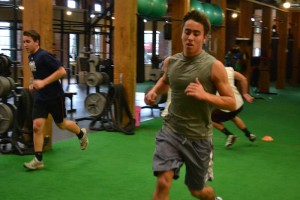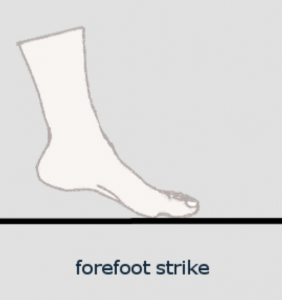Every fall and spring as athletes transition back to their field sports, they inevitably find themselves riddled with hamstring pulls and hip flexor strains.
Often times athletes are procrastinators, and they try to cram what should have been 3 months worth of training into a 3-week period when they realize pre-season is right around the corner.
Now, I know I can’t change the procrastinators out there, but I know a thing or two about training athletes.
There are several reasons why hamstring and hip flexor injuries are common, but often times it’s a result of poor hip function, specifically hip mobility. Hockey players transitioning to lacrosse or baseball run like they still have skates on and soccer/football players are battling muscles pulls because for many of them it’s the first time they’ve sprinted in months.

So let’s dive in. What is actually going on anyways?
The ability to flex one hip while extending the other is vital when it comes to sprint mechanics. If the athlete lacks this skill, there may be some potentially negative consequences.
If an athlete is restricted in the anterior hip, the glutes may not do their part in hip extension. If the glute cannot aid in hip extension, the hamstrings will kick-in to complete the job and will likely become overworked. This normally presents itself as a hamstring pull or strain. When tested in an isometric fashion, the hamstring may be very strong, but when it has to do the job of an ineffective glute, it will eventually become strained/pulled. Essentially, the hamstrings take on more than they can handle and injuries happen!
Unfortunately, when these things occur, trying to rehab the issue is going to be a lengthy process because usually the athlete’s already behind the eight ball and the season is days away.
The key here is to prevent this situation by being proactive in health and performance instead of reactive when an injury occurs.
Just like Ben Franklin said:
“When you fail to plan, you plan to fail.”
In a perfect world, we would identify and clean up any mobility restrictions in the anterior hip, teach athletes how to use their glutes in a healthy fashion, and teach them how to run correctly. From my experience, once we get the glutes to join the party, hamstring issues are at least mostly resolved.
From an assessment standpoint, there are two assessments that will give you some excellent information regarding hip function.
The ASLR (active straight leg raise) from the Functional Movement Screen is a great evaluation for this. The goal of this screen is to assess pelvic stability, hip flexion in one hip while simultaneously assessing hip extension in the opposite.

The second assessment we use is the in-line lunge. The in-line lunge assesses foot, ankle, knee, and hip stability and mobility simultaneously. Assessing the in-line Lunge on both sides will give us pertinent information as to whether or not there are left to right and right to left asymmetries in the lunging pattern.

The mechanics in the lunge pattern are similar to gait so often times this assessment gives us a good snapshot of lower body function.
I’m not saying that testing well in these two assessments will protect you from injury, but I do believe that identifying and correcting these asymmetries and/or mobility restrictions lowers the risk of injuries like hamstring pulls and hip flexor strains.
Tempo Running for Athletes
So let’s say the athlete does indeed own these patterns, what’s next? The tempo run is an excellent way to cement these patterns, improve running mechanics, and simply to get in great shape!
So what is tempo running?
Tempo running is interval-based running designed to increase work capacity, strengthen/reinforce running mechanics and build the aerobic base.
Find your groove with tempo running:
- In general, tempo runs are performed at 70% of your max effort.
- Tempo runs shouldn’t destroy you, but you should feel challenged.
- They key is to “find a groove” that allows you to slowly increase your stride length over time. It’s important not to force your stride length, but rather to allow your hips to adapt over time. Once you find your groove, you should feel like you are moving at a decent pace, but also have another gear if you want to hit top speed.
- To me, tempo running always feels like I am floating across the pitch. It’s a challenging, but viable pace.
Here are a few teaching points to consider:
 Maintain good stability in the lumber spine and pelvis as you run.
Maintain good stability in the lumber spine and pelvis as you run.- Practice proper arm action when running.
- Stay relaxed and try not to be too tense in your upper body.
- Focus on pushing off the ball of your foot. Think about how your foot lands when jumping rope and use that same footstrike.
- Focus on quality of movement! If you start to get sloppy, rest longer or shorten the tempo run.
Here is a simple template you can follow to gradually get back into sprinting shape.
- You will train 2x a week, preferably with 2 days of rest in between training days. A good example would be a Monday / Thursday training schedule.
- Soccer and Lacrosse players can use the suggested yardage below, football players can cut the distance in half, but keep the sets the same.
- As far a rest time goes, :60 to :90 is a good place to start!
Week # 1- All 60 yd runs
Day #1 5 sets
Day #2 7 sets
Week #2- All 60 yd runs
Day #1 8 sets
Day #2 10 sets
Week #3 All 60 yd runs
Day #1 12 sets
Day #2 15 sets
Week #4 All 80 yd runs
Day #1 6 sets
Day #2 8 sets
Week #5- All 80 yd runs
Day #1 8sets
Day #2 10 sets
Week #6 All 80 yd runs
Day #1 12 sets
Day #2 15 sets
Week #7 All 100 yd runs
Day #1 6 sets
Day #2 8 sets
Week #8- All 100 yd runs
Day #1 8sets
Day #2 10 sets
Week #9 All 100 yd runs
Day #1 12 sets
Day #2 15 sets
Give this a try and let us know how it goes!!

As always, train smart and train hard!!
Our Summer COMPETE. Sports Performance Training Schedule starts June 29th!

One Comment
Comments are closed.